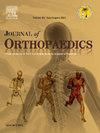Biceps tenodesis in the setting of total shoulder arthroplasty: A matched cohort analysis
IF 1.5
Q3 ORTHOPEDICS
引用次数: 0
Abstract
Background
Studies have theorized that pain refractory to anatomic total shoulder arthroplasty (aTSA) in patients who did not undergo a concomitant biceps tenodesis or tenotomy may be as a result of the pathologic interaction between the long head of the biceps tendon and the humeral prosthesis. This study evaluates the effect of concomitant biceps tenodesis during aTSA on long-term clinical and radiographic patient outcomes.
Methods
This retrospective study analyzed patients who underwent aTSA with or without biceps tenodesis from 2000 to 2017. Preoperative and postoperative range of motion (ROM), American Shoulder and Elbow Surgeons (ASES), Visual Analog Scale (VAS), and Simple Shoulder Test (SST) scores were collected. Patients in the biceps tenodesis group were matched with those who underwent aTSA without tenodesis based on age, follow-up interval, sex, and preoperative ASES score.
Results
The study included 88 shoulders (44 tenodesis, 44 no tenodesis), with median follow-up of 9.9 years (range 3.3–19.0). No significant differences were observed between cohorts in postoperative forward elevation, external/internal rotation, VAS, ASES, or SST scores at most recent follow-up. There were no significant differences in pre-to postoperative improvement in ROM and patient-reported outcome scores. Both groups demonstrated excellent implant survival, with similar revision rates at nearly 10 years postoperatively.
Conclusions
Patients who underwent aTSA with concomitant biceps tenodesis did not demonstrate inferior long-term clinical outcomes or pain scores in comparison to patients who underwent aTSA with preservation of the biceps tendon. Appropriately selected patients may experience equivalent, satisfactory outcomes after aTSA, independent of concomitant biceps tenodesis.
求助全文
约1分钟内获得全文
求助全文
来源期刊

Journal of orthopaedics
ORTHOPEDICS-
CiteScore
3.50
自引率
6.70%
发文量
202
审稿时长
56 days
期刊介绍:
Journal of Orthopaedics aims to be a leading journal in orthopaedics and contribute towards the improvement of quality of orthopedic health care. The journal publishes original research work and review articles related to different aspects of orthopaedics including Arthroplasty, Arthroscopy, Sports Medicine, Trauma, Spine and Spinal deformities, Pediatric orthopaedics, limb reconstruction procedures, hand surgery, and orthopaedic oncology. It also publishes articles on continuing education, health-related information, case reports and letters to the editor. It is requested to note that the journal has an international readership and all submissions should be aimed at specifying something about the setting in which the work was conducted. Authors must also provide any specific reasons for the research and also provide an elaborate description of the results.
 求助内容:
求助内容: 应助结果提醒方式:
应助结果提醒方式:


